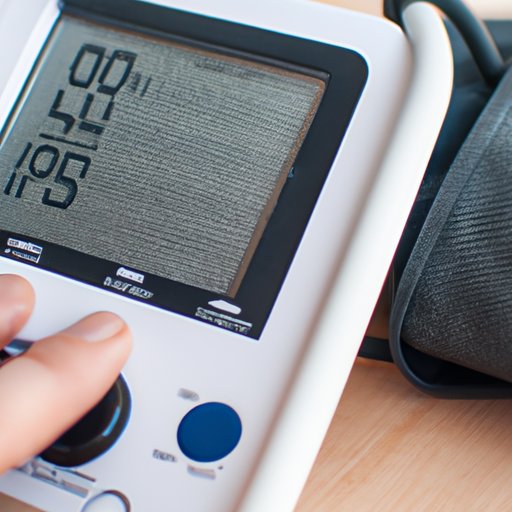
Introduction
Mean arterial pressure, commonly known as MAP, is an important clinical parameter used to determine the average pressure in arteries during one cardiac cycle. It is an essential indicator of cardiovascular health, which is why knowing how to calculate MAP is crucial for healthcare professionals, such as doctors, nurses, and paramedics.
This article aims to provide a comprehensive guide on understanding the importance of MAP, its clinical applications, and practical demonstration of its calculation. Additionally, it addresses common misconceptions and limitations associated with the use of MAP in assessing cardiovascular health.
What is Mean Arterial Pressure?
Mean arterial pressure refers to the average pressure in arteries that supply blood to vital organs such as the brain and heart. Blood must flow continuously to these organs to ensure optimal function. The MAP is responsible for maintaining proper blood flow, and variations in MAP can impact blood supply to organs.
The formula for calculating MAP is (2 x diastolic blood pressure + systolic blood pressure) / 3. The diastolic blood pressure (DBP) represents the pressure in the arteries when the heart is at rest, and systolic blood pressure (SBP) refers to the pressure exerted by the heart during contraction.
For instance, if a patient has a blood pressure reading of 120/80 mmHg, the MAP can be calculated as follows:
(2 x 80 mmHg + 120 mmHg) / 3 = 93.3 mmHg
The resulting number provides the average pressure in the arterial vessels of the heart and brain during one cardiac cycle.
Clinical Significance of Mean Arterial Pressure
MAP is a crucial indicator of cardiovascular health and is used by healthcare professionals to monitor changes in blood pressure in patients with cardiovascular diseases such as hypertension, hypotension, and shock. Monitoring MAP in these patients is essential as it can aid in the early detection of potential complications.
Furthermore, MAP can be affected by various factors such as heart rate, stroke volume, and peripheral resistance. For instance, increased heart rate and decreased stroke volume can result in a lower MAP that can have detrimental effects on organs such as the brain and heart. Therefore, monitoring MAP can help medical professionals detect these changes and take corrective measures.
Moreover, estimating MAP is crucial in clinical scenarios such as during surgeries where the blood pressure of the patient may fluctuate. MAP allows healthcare providers to monitor and maintain stable blood pressure levels during these procedures.
The interpretation of MAP results can provide valuable insight into the patient’s cardiovascular health. A MAP range between 70-110 mmHg is optimal, indicating proper blood flow and perfusion. MAP values lower than this range are indicative of hypoperfusion and may warrant medical intervention.
Practical Demonstration of Calculating Mean Arterial Pressure
Calculating MAP can seem daunting, but with practice, it can be mastered. A practical example can help demonstrate how to calculate MAP accurately:
If a patient has BP readings of 130/90 mmHg, the MAP is:
(2 x 90 mmHg + 130 mmHg) / 3 = 103.3 mmHg
Thus, the MAP for this patient is 103.3 mmHg. The result indicates the average arterial pressure during one cardiac cycle in the patient’s body.
To calculate MAP, it is crucial to use accurate BP readings. Common mistakes include using incorrect values or rounding figures, which can significantly impact the final result.
Medical professionals must ensure the correct placement of the BP cuff and proper positioning of the patient during BP measurement. Additionally, multiple BP readings may be taken before calculating MAP to ensure accuracy.
Common Misconceptions About Mean Arterial Pressure
Several misconceptions surround MAP and its significance in cardiovascular health. One common myth is that a lower MAP is always better and indicates better cardiovascular health. However, low MAP values can also be indicative of hypoperfusion, leading to organ failure.
Another misconception is that MAP is only a concern in specific groups such as older adults or patients with preexisting cardiovascular diseases. In reality, monitoring MAP is critical for individuals of all ages and medical histories.
Lastly, some may believe that MAP can be determined solely through the measurement of DBP and SBP. While these values are used to calculate MAP, other factors such as heart rate and peripheral resistance also impact MAP.
Limitations and Potential Errors of Using Mean Arterial Pressure
Using MAP as a sole indicator of cardiovascular health can have limitations. For instance, MAP does not account for variations in blood pressure that occur during a cardiac cycle. Additionally, certain medical conditions such as aortic regurgitation or aortic stenosis can significantly impact MAP, resulting in values not indicative of the patient’s actual cardiovascular health.
Therefore, healthcare providers must use complementary approaches such as other blood pressure measurements, such as pulse pressure or central venous pressure, and diagnostic tests to gain a complete understanding of the patient’s cardiovascular health.
Conclusion
Mean Arterial Pressure is a crucial indicator of cardiovascular health. Accurate calculation of MAP can aid healthcare professionals in early detection and intervention of cardiovascular diseases. With this comprehensive guide, understanding the importance of MAP, its calculation, and clinical applications have become more accessible. It is essential to remember that MAP is one piece of the puzzle in assessing cardiovascular health, and additional approaches should be used in conjunction for a complete picture.




